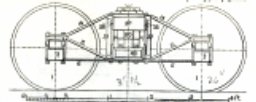It is very difficult to pin down the types of trucks that existed in each of the classes and the eras of usage, Some of the more durable designs had an extended life-span of well over fifty years and more in non-revenue service. Classes A, B, some C and probably some D were built before the establishment of classes. They were probably assigned to a class, if they met or exceeded the class axle loading. Other factors that prolonged usage by many railroads were the prohibitions imposed by rail weight, industrial sidings and bridge loading. There was also a lag of a few years between the introduction of a radically improved design and acceptance by railroads.
Although higher axle loading would seem to indicate heavier frames, the loading is normally determined by journal size. Frequently in tender trucks and other specialized applications, odd journal sizes were used with standard frames to increase loading. These subtleties are not discernable externally. Therefore the next discussion can only be very general in nature.
Prior to the early 1860's, there were practically no standards. Even track gauge was a shamble, ranging from 2 to 5 feet. Only the necessity to move Civil War commodities and troops forced the Union military to re-gauge a large percentage of track to the present 4' 8.5" standard. Trucks and cars were often homemade in local railroad shops; so variations on the same road could be extreme. Four wheel cars were still made and used. Probably none met the class A minimum.
NOTE: Drawings are from an old Simmons-Boardman Car-Builders Dictionary's and Cyclopedia.
Up to the 1870's, trucks were mainly wooden with iron strap supports and hardware and most had brake gear. Wooden spring bars were used under the truck bolsters.


WOOD BEAM--ARCHBAR--PASSENGER
Neither the wood beam nor archbar freight truck had sideframe springs and ranged from 3' to 4'-6" wheel base. Passenger trucks were woodbeam;
 sprung at the pedestals or equalizers and ranged from 5' to 6'-6" wheelbase.
Unfortunately most model manufacturers ignore this and provide 5'-6" freight
trucks.
sprung at the pedestals or equalizers and ranged from 5' to 6'-6" wheelbase.
Unfortunately most model manufacturers ignore this and provide 5'-6" freight
trucks.
As cars grew longer and heavier in the 1880's, woodbeam freight trucks were replaced with a wide variety of archbar designs of increasing wheel bases with springing between the bolsters and sideframes. Many designs were developed, with varying degrees of success. Sideframe designs varied in the angles of the upper and lower arches. Equal angles were commonly referred to as "diamond" archbars. Most had journal straps across the bottom.
Six wheel passenger trucks became common in the 1890's on sleeping cars by Pullman and others. They were also used on coaches by roads with light rails through to the end of the heavyweight era in the 1950's. Riveted structural steel sideframes were developed.
Around 1900 pressed steel, freight side frames were tried by a Fox patent with pedestal springs. Several pressed steel archbar types were introduced by Cleveland, Pressed Steel, and Buckeye. Cast steel sideframes with pedestal springs were offered by Ajax . Shortly after, Bettendorf introduced the cast steel prototype with bolster end springs, steel springbar and no journal straps as a precursor to the later AAR truck. These and similar designs gradually replaced most others. Six wheel archbar and cast trucks appeared for heavy loads.
Through the teens, many railroads were reluctant to completely replace archbars having serviceable journal boxes. The "crown" cast sideframe with journal straps was designed to utilize these boxes for upgrade. Erroneously these are referred to as Andrews by modellers, but they only produced a small percentage. Specialized tender trucks began to appear in a wide variety.
Although designs changed slightly, cast steel sidebeams and parts replaced most riveted structural steel on passenger trucks. Most headend cars over 60 feet had 6 wheel trucks.
By the 1920's, cast frames were used in all new construction and many variations were developed in freight, passenger and tender trucks. Many archbars were still in service until about the end of the 30', when they were banned from interchange . However some lasted into the 90's in company service. The AAR introduced standard recommend side frames. The 4 wheel version is erroneously called Bettendorf by modellers. Since they only produced a small percentage, these should be referred to as AAR type or the correct manufacturer name; unless they are actually Bettendorf.
During the 30's roller bearings became common, with the noticeable round covers on journal boxes. With the introduction of light weight passenger cars, 4 wheel trucks became common on sleepers, other extra fare cars and headend cars.
Although many designs have been developed, the vast majority of freight cars have used AAR types or variations by diverse manufacturers; the major exceptions were used on special service cars.
 BETHLEHEM CAR WORKS
BETHLEHEM CAR WORKS
